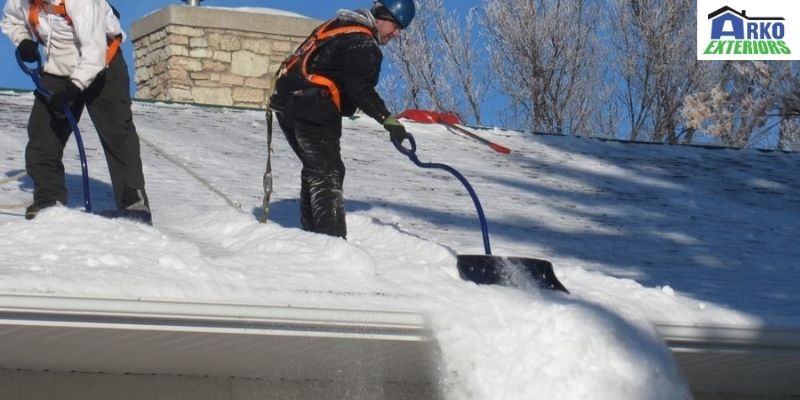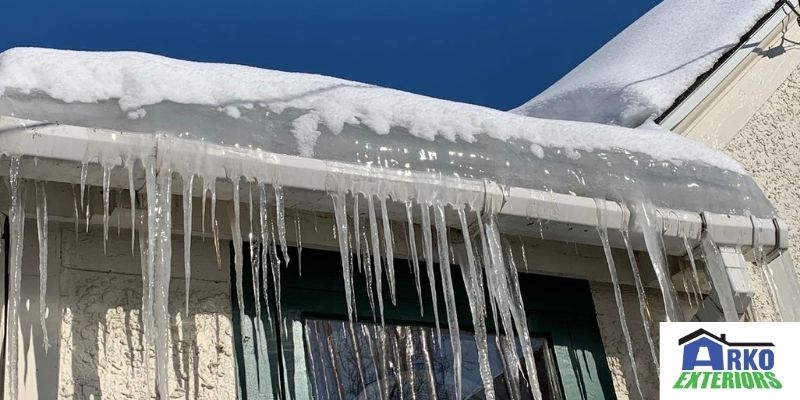Ice dams tend to form on the edges of the roof. The risk of damage increases if the ice dam remains for a long time. You should remove it from your roof as well as address the cause. Otherwise, it may lead to bigger issues like leaks, causing water damage to the home. However, you must be careful when removing ice from your roof to avoid further damage.
Here is a guide to help you in the removal process…
How To Safely Remove Ice Dams

An ice dam can cause a lot of trouble for homeowners. The possible leaks from it can warp floors, peel paint and cause the growth of mold, mildew, etc. To avoid any of these issues, you must get rid of the ice. However, some ice removal methods are safer than others.
Here is how to safely remove an ice dam from your roof…
1. Install a heat cable
A heat cable is an efficient method for ice removal. Not only will it help melt the snow that causes an ice dam and make the water drain through your gutters and downspouts, but it will also prevent the formation of ice dams.
Depending on what you want, you may have your roofer install it permanently or temporarily. Either way, it is a solution to your ice dam problems. You can have heat cables installed in the summertime so that they will be ready when the cold weather comes.
2. Blow cold air through your attic
The rising of hot air from your home to the roof is one cause of ice dams. The hot air causes the snow on your roof to melt. Upon reaching the edges and eaves of your roof, the melted snow freezes again because it is colder in those areas. This causes ice dams to form.
One easy way to fight this is to place fans in your attic. Let them be pointed directly to your roof. This will keep the underside of your roof cold. As a result, the snow won’t melt, and the formation of ice dams will not happen.
3. Use hot water
The use of hot or warm water is another method of ice dam removal. You can make use of a hose or a gardening sprayer to pour warm water on the ice dam. As a result, the ice dam at the eaves and edges of your roof will melt and drain through your gutters. However, ensure that you are careful while doing this. The water you use should not be too hot as that can result in a burn.
4. Warm weather
If there is an ice dam on your roof and warmer weather is on its way, do not stress yourself. This is because it is likely that the weather will melt the ice for you. After that, you can have the remaining snow on your roof removed.
You must remove the snow because warmer weather can melt and make it become an ice dam if it refreezes at the colder region of your roof. However, it is recommended that you let snow remain on your roof to prevent damage to your shingles.
5. Call a professional

If you do not want an icy roof and you do not know how to go about clearing it, hire a roofing company to do the job. The methods of ice removal already discussed may also be strenuous for you to carry out. Therefore, it is a good idea to call a professional.
With a roofing professional, you just have to watch them do the job properly. With the appropriate tools and equipment in their possession, they will help remove the ice dam. If the ice dam has caused damage to your roof, they will also repair it.
How Not To Remove Ice Dams
While it is recommended that you hire a professional for ice dam removal, you should know that some ice dam removal methods are not safe. Knowing this will ensure that your roof is protected and the ice dam is safely removed. You must avoid removing the ice dam manually or with chemicals.
Here are further details on how not to remove an ice dam:
1. Manual removal
This is an ice removal method you should avoid. Many people use hammers or chisels for ice dam removal. It is not the best idea, and it poses a safety risk. This is because you can cause further damage to your roof if these tools hit it hard.
Only use a rake if you insist on using hand tools to remove the ice. This is because some rakes are designed to remove clutter from gutters and roofs. A roof rake’s long handle allows for a more convenient standing position when you try to remove the ice.
Furthermore, the exterior temperature of your roof changes when you rake snow and ice off it. This, in turn, will prevent the ice dam from building up. Therefore, any major issue will be avoided as a result.
2. Chemicals
The use of chemical de-icing products in removing ice dams is another method that roofers employ. These de-icers contain chemicals that will increase the rate at which the ice melts. They are available at home improvement and local hardware stores. However, you must avoid using them on your roof.
Furthermore, there are de-icing tablets available. These chemically induced products are not recommended for an asphalt roof. The effects these chemicals can leave on your asphalt shingles are negative. It can also be very devastating if they are left on your roof for long periods of time. Damage, as a result, may even void your manufacturer’s warranty.
Conclusion
An ice dam can be a menace to you as a homeowner. However, you may need to remove them if they form. This is to help you minimize safety risks. You can remove the ice yourself now that you are aware of what to do and what not to do. Addressing the root cause of ice dam formation like poor attic ventilation and/or a poorly maintained gutter is the best way of preventing them. Always consult professional roofing experts to maintain your roof for many years. Locally, hire Arko Exteriors for professional ice dam removal services; Call 763-434-2756 for more information.

